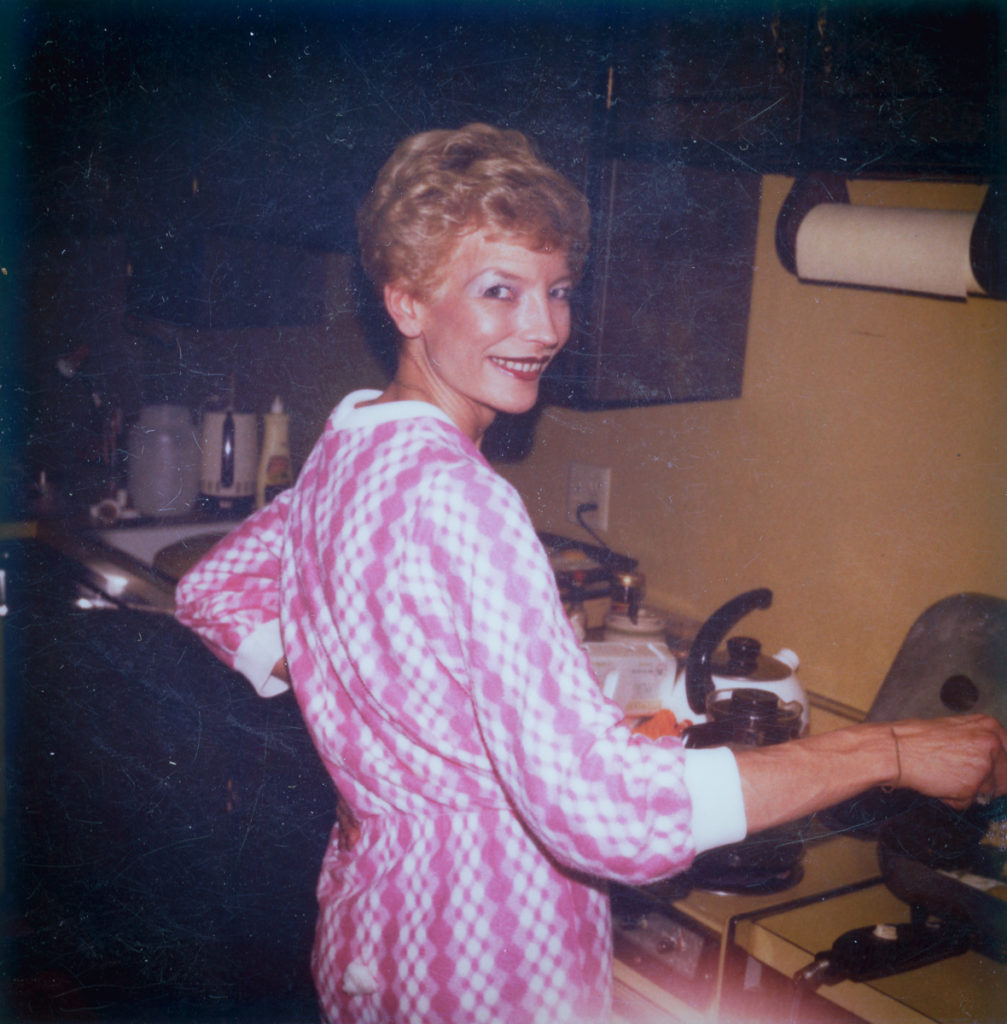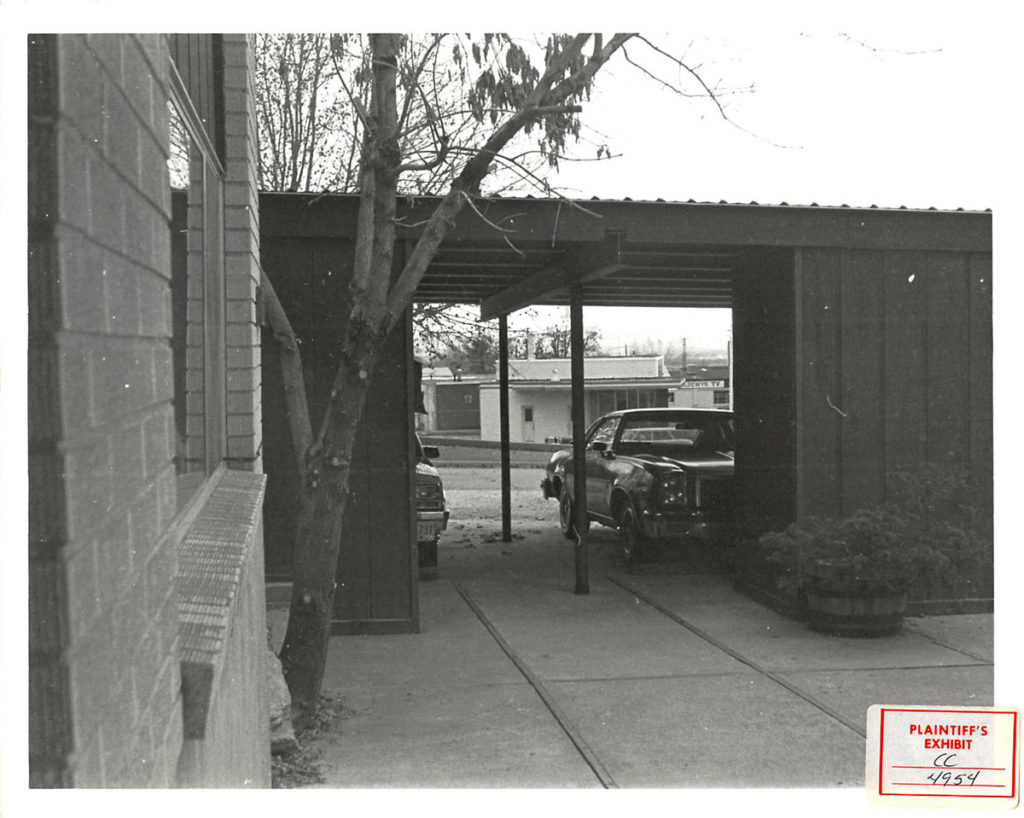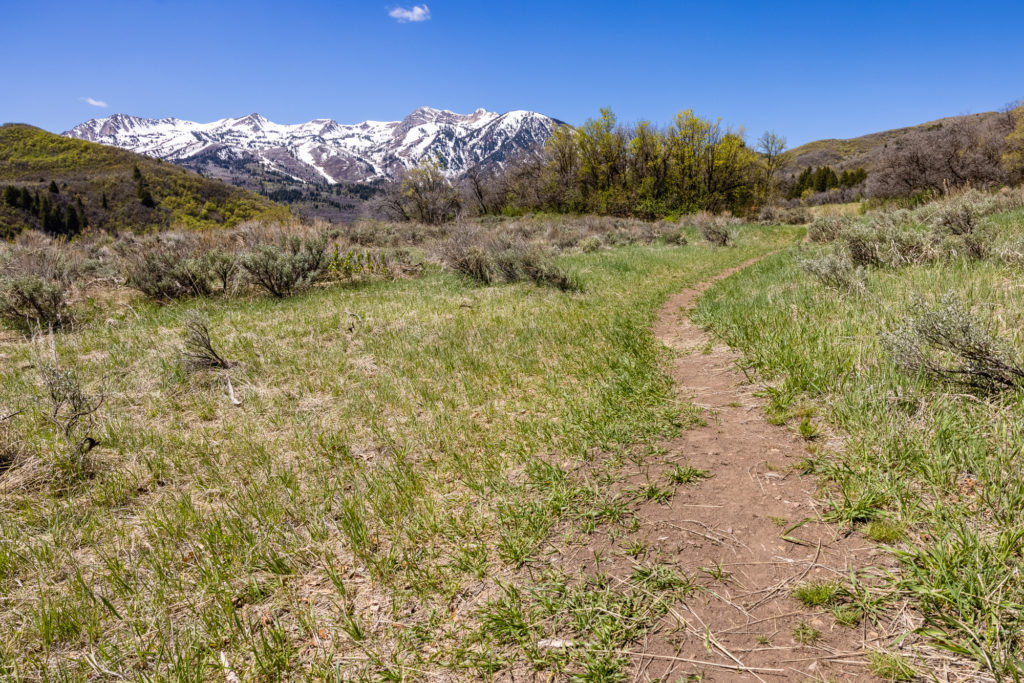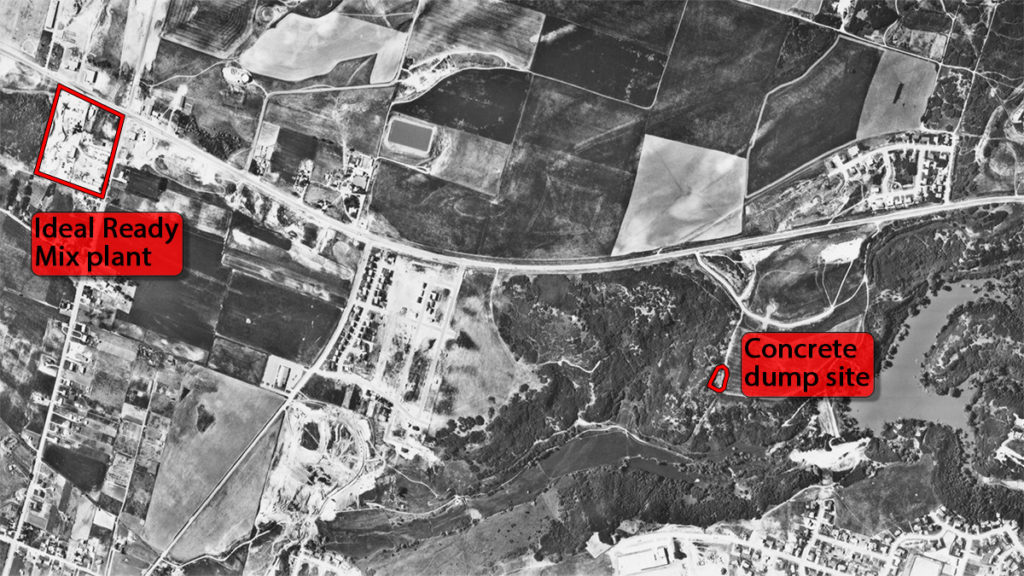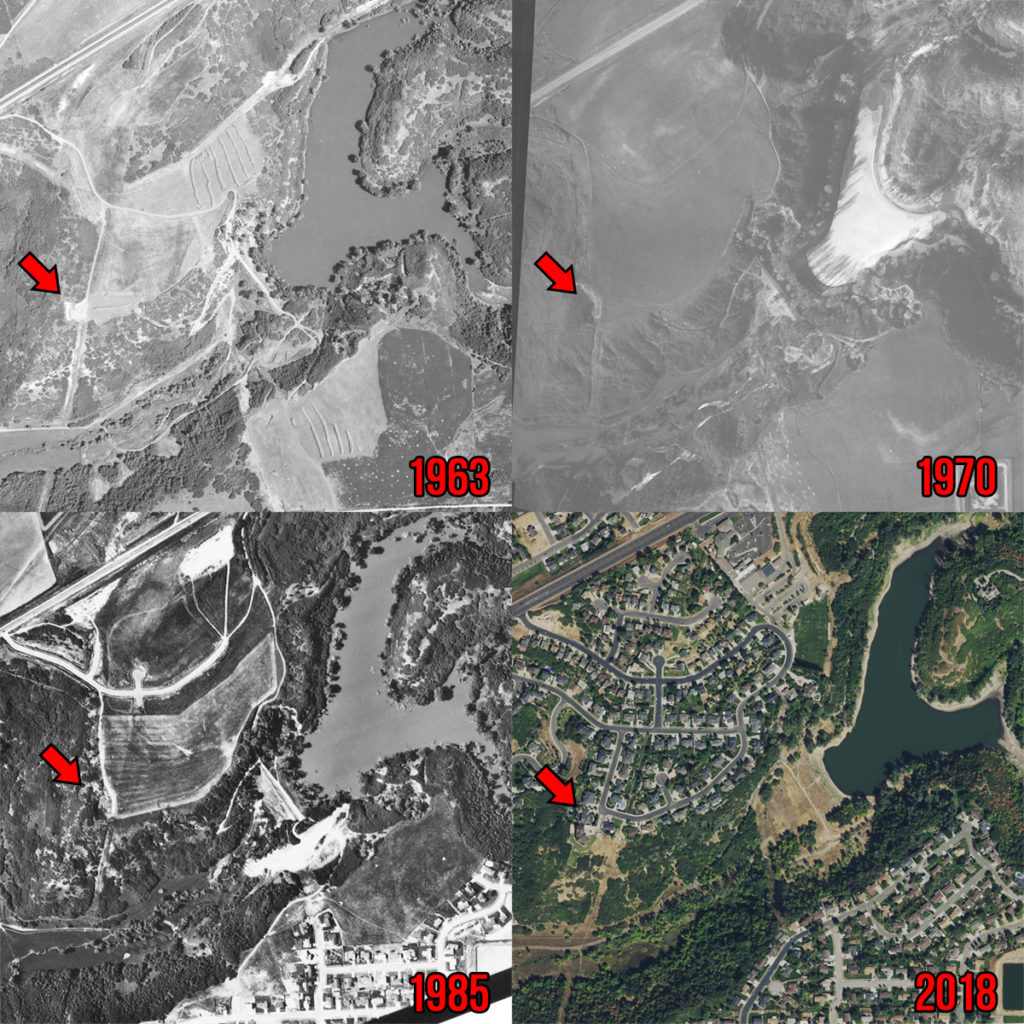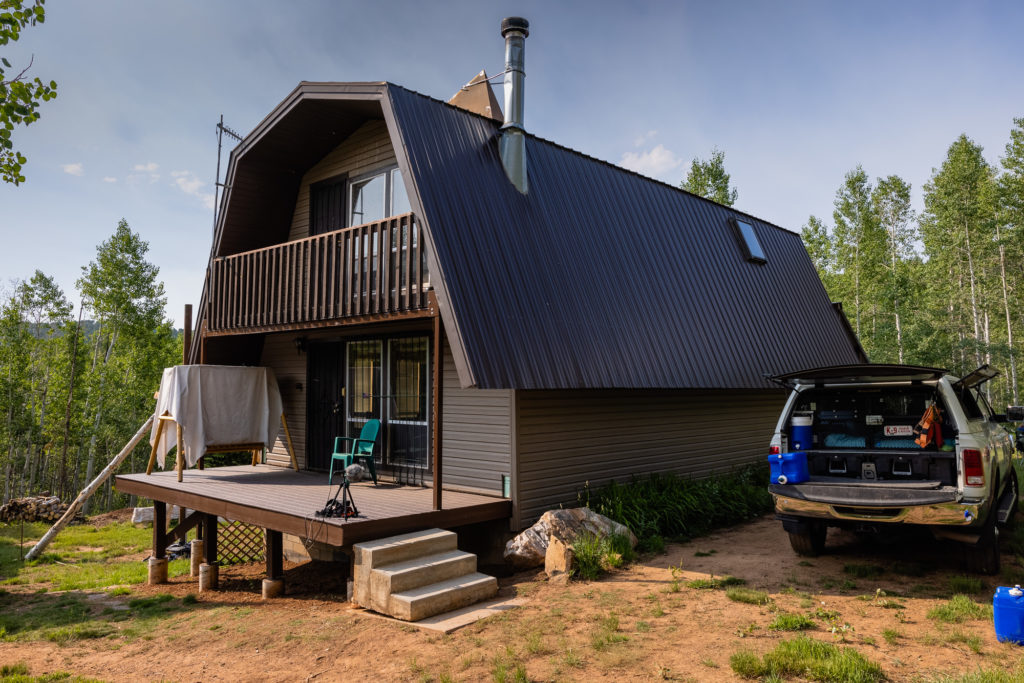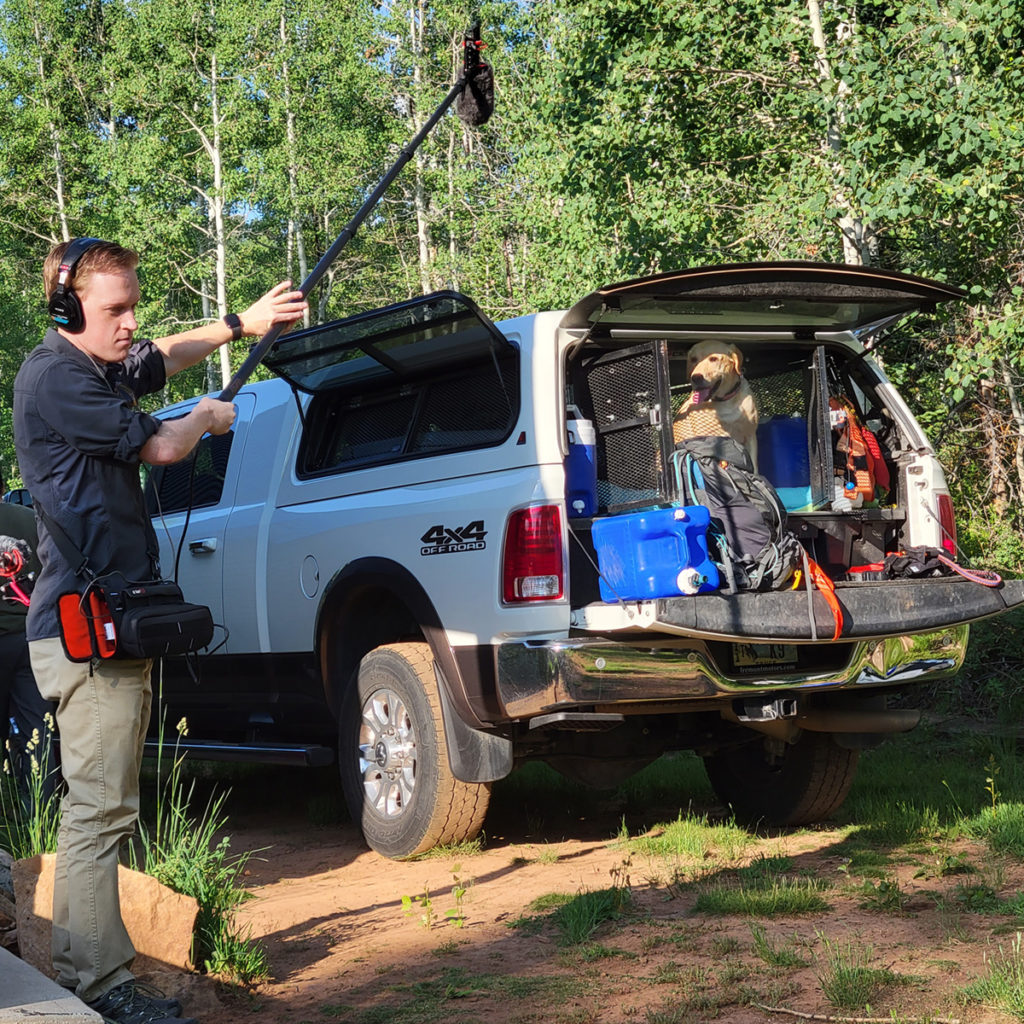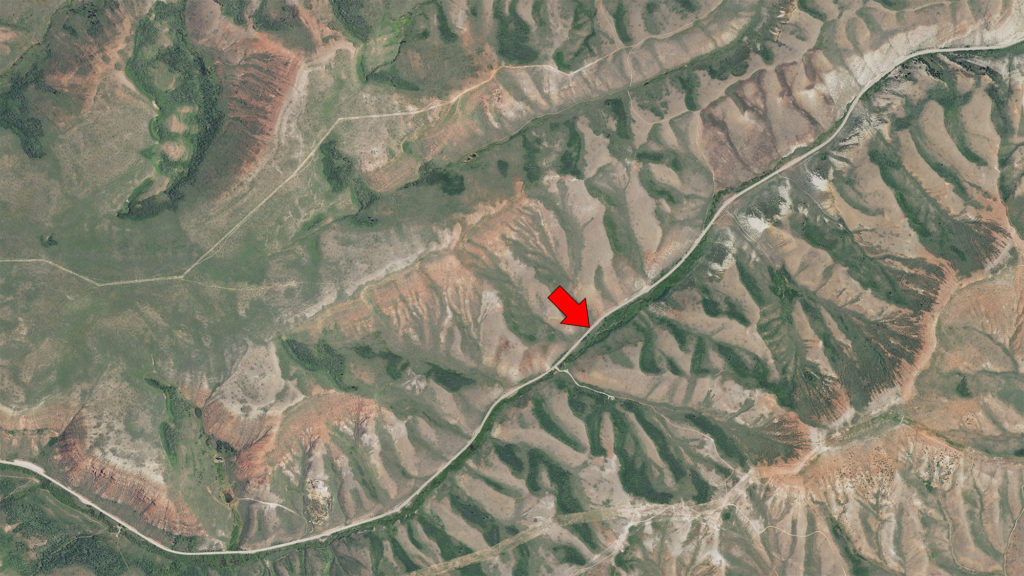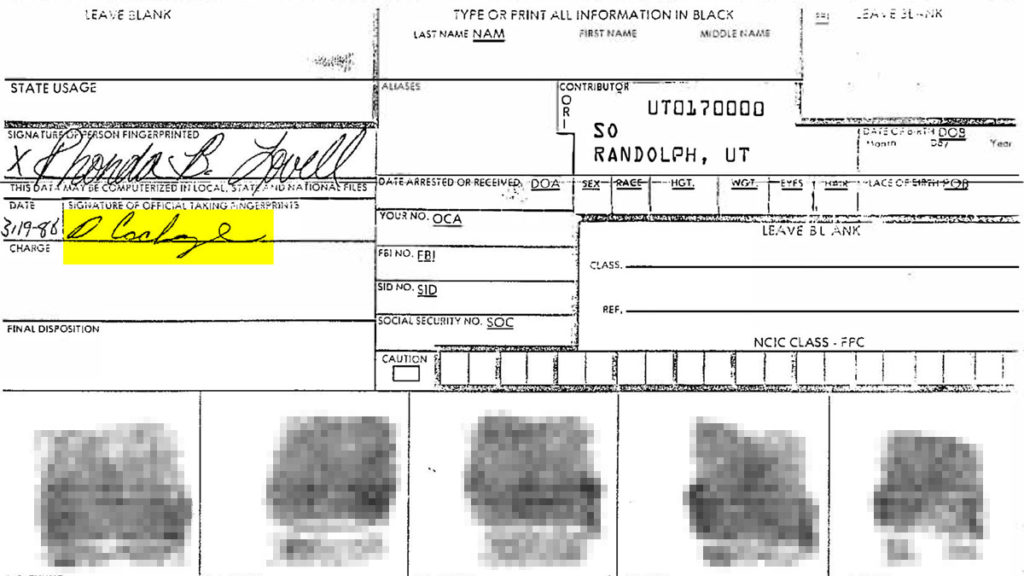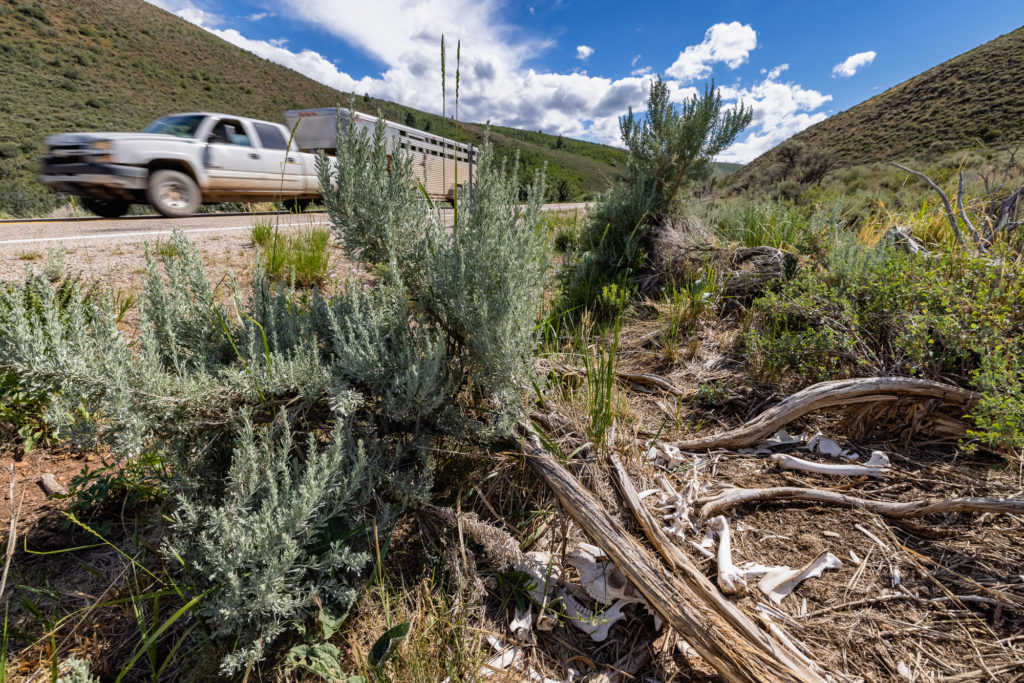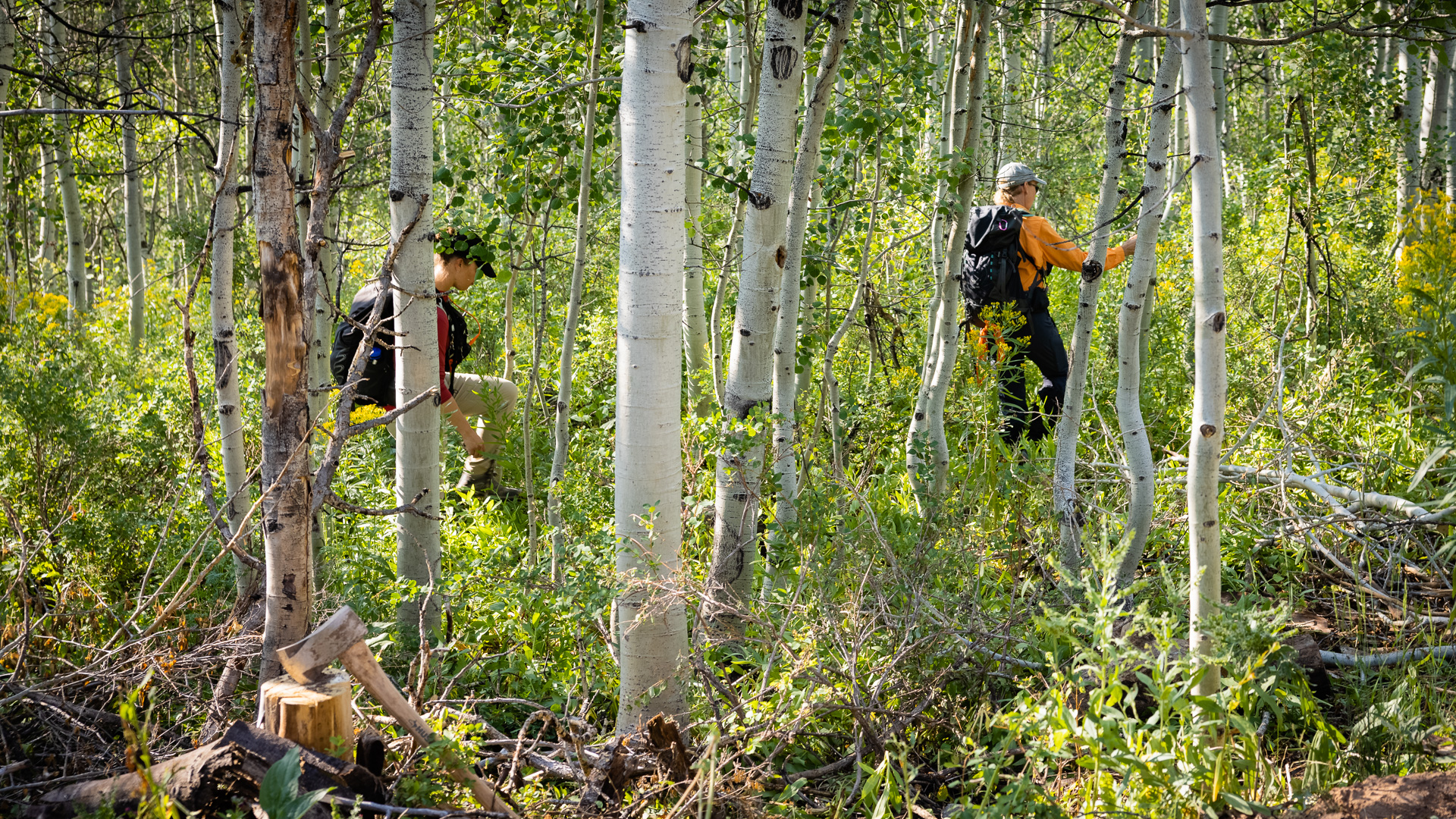Dave Cawley: I’m standing at a gravel pull-out on the side of the Old Snowbasin Road. I’ve just finished putting a microphone on Terry Carpenter, tucking it under his collar in a futile effort to shield it from the breeze.
Terry Carpenter: He says this is where it was. Right up in here.
Dave Cawley: It’s May of 2021 and I’ve met Terry here on a bluebird Saturday so he can show me where Doug Lovell claimed to have buried the body of Joyce Yost. We walk a path between thick patches of oak brush, up and over a berm a hundred feet or so from the road.
Terry Carpenter: This is one of the first places that he, this was all flat. These, these have been added since then.
Dave Cawley: We come to a clearing. I can see the east face of Mount Ogden four miles off in the distance, the ski runs carved through the trees below the peak still decked with winter snow. To my left, the ground drops away to a valley. To my right, it rises to a ridge. I’m impressed in this moment how much smaller the terrain makes the search area seem compared to what I’d pictured. It’s still large — say, three or four acres — but not so expansive as to make a search impossible.
Terry Carpenter: Anything that would indicate there was a disturbance there, we dug in those areas and we, with the permission of the Forest Service we dug that area to try to locate what we thought might be Joyce’s grave.
Dave Cawley: There are signs of recent use all over the place: campfire rings, beer cans, shell casings. I pick my way into the oak brush at one point and find a rusted out metal drum surrounded by partially burned scrap lumber. It’s obvious people come here with some regularity. Terry’s eyes grow distant as he talks about that search back in the summer of ’93.
Terry Carpenter: We, we just exhausted every effort we could think of hoping that we could come across something that might produce Joyce.
Dave Cawley: What’s most frustrating is the uncertainty.
Michael Bouwhuis: Let’s suppose that he did remember exactly where he’d put the body…
Dave Cawley: This is Michael Bouwhuis, the attorney who represented Doug during his 2015 murder trial.
Michael Bouwhuis: …the challenge is that after eight years there wouldn’t be hardly anything left, if anything at all.
Dave Cawley: In an interview for our companion podcast Talking Cold, Michael said he learned the police in ’93 had not consulted a forensic anthropologist before they started sticking shovels in the ground.
Michael Bouwhuis: And so if Doug left her at the spot where he took the authorities, the way that they processed the scene would have produced nothing. … He could have been telling the truth that she was here and simply was either moved from that spot — a bear certainly could have done that, a mountain lion could have done that — or through the process of disarticulation scattered to the wind.
Dave Cawley: Disarticulation is when a body comes apart. The connective tissues holding the skeleton together break down in the later stages of decomposition, leading to scattering of individual bones. With a badly disarticulated set of remains, bone chips or a single tooth might be all that’s left.
Michael Bouwhuis: So if the body had been there, eight years earlier, the scene was obliterated.
Terry Carpenter: You would’ve thought with the animals that roam the area of natural habitat, coyotes, they would’ve dug that up. That something would’ve been exposed on the surface. Somebody would have found a bone. (Sighs)
Dave Cawley: Terry asserts Joyce was never here, that Doug lied. But Michael contends that’s not the only plausible explanation.
Michael Bouwhuis: It could be that he didn’t know at all, he didn’t remember it but he thought ‘if I act like I do and I put an effort in and they appreciate that, maybe they cut me a break.’ Or it could be that he knew it wasn’t there, it was somewhere else.
Dave Cawley: Somewhere else. This is a bonus episode of Cold, season 2: Location, Location, Location. From KSL Podcasts, I’m Dave Cawley. We’ll continue after this break.
[Ad break]
Dave Cawley: Any conversation of where Joyce Yost’s remains might be — if not where Doug Lovell claimed — requires engaging in speculation. During Cold season 2, you heard a few different places mentioned, like the ghost town of Yost, or even Causey Reservoir. But in this episode, we’re going to visit three other places where Joyce Yost’s remains might rest. They are: a cement dump site near where Doug worked in 1985, behind the cabin Doug’s family owned at Sunridge Highlands and in the Monte Cristo Range where a wildlife officer spotted Doug and Rhonda weeks or months after Joyce Yost disappeared.
If we’re going to draw any meaningful conclusions though, we need to buttress our conjecture with fact. So let’s review what we know, starting with the timeline of Joyce’s murder. When Rhonda Buttars first confessed her involvement, she said she’d dropped Doug off outside Joyce’s apartment…
Rhonda Buttars (from May 1, 1991 police recording): I’d say, I don’t know. 11, between 11 and 1.
Terry Carpenter (from May 1, 1991 police recording): Ok.
Dave Cawley: …between 11 p.m. and 1 a.m. In later court testimony, Rhonda would describe seeing Joyce’s car parked outside the apartment, which would place the drop-off sometime after Joyce returned home from the officer’s club around midnight. Rhonda said she’d received a call from Doug the following morning telling her to meet him at the Wilshire, a movie theater in South Ogden…
Rhonda Buttars (from May 1, 1991 police recording): Umm, I would say 4 to 5 in the morning.
Dave Cawley: …between 4 and 5 a.m. Rhonda based this on her observation that the sky was dark at the time of the call but just starting to get light when she’d made it to the Wilshire.
Rhonda Buttars (from May 1, 1991 police recording): What time does the sun come up? 6?
Terry Carpenter (from May 1, 1991 police recording): I’m not really sure, then. I think maybe around 5.
Dave Cawley: I’ve checked an almanac. Sunrise in Ogden, Utah on August 11, 1985 was at 6:34 a.m. The sky would’ve been fully light by then, so we need to wind back the clock about an hour to get to the start of the pre-dawn twilight. That would likely place Doug’s phone call between 5 and 5:30.
Rhonda’s account, if accurate, tells us Doug window’s of opportunity was open a maximum of five hours, from 12:30 to 5:30. I stress, this is the max. What was Doug doing during that time? By his own account, he entered Joyce’s apartment, scuffled with her on the bed, cut her, bandaged her bleeding wound, stripped the bedsheets, flipped the blood-stained mattress, remade the bed and packed her suitcase. Rhonda said Doug had told her this all took “quite awhile.”
Rhonda Buttars (from May 1, 1991 police recording): So he said that took quite awhile and that he was in her apartment for quite awhile.
Dave Cawley: But what’s awhile? 15 minutes? An hour? Rhonda wasn’t specific, so we have to make an assumption. As a rough guess, let’s say Doug’s activities in the apartment took half an hour. I’d consider that a conservative estimate. That leaves, at most, four-and-a-half hours for Doug to take Joyce out to her car, travel to wherever he took her, conceal her body, then drive back and find a payphone in order to call Rhonda. Doug had premeditated Joyce’s murder, so we can assume he knew in advance where he was headed and drove straight there and back.
Terry Carpenter (from May 1, 1991 police recording): How was, what’s he acting like, what’s he, how is he coming across to you?
Rhonda Buttars (from May 1, 1991 police recording): He’s kinda nervous, kinda not, not really nervous.
Dave Cawley: Trim off a little more time to account for Doug’s actions at the drop site and we’re left with a maximum of four hours for travel, round-trip. Which means the drop site was likely within a roughly two-hour drive one-way from South Ogden. The Old Snowbasin Road site Doug identified as being the place he left Joyce’s body is a 30-minute drive from Joyce’s apartment. One could argue it’s too close. It would’ve left Doug with too much time.
Remember as well that Rhonda said Doug’d told her he’d taken Joyce “up by Causey.” And Doug told Rhonda in the second wire recording at the prison Joyce was in the mountains, at a place where she was covered by years of accumulated leaves. With all that in mind, let’s take a look at our first alternate theory for the location of Joyce Yost’s remains: the cement dump site.
[Scene transition]
Dave Cawley: Let me introduce you to “Dangerous” Dan and his wife LuAnne.
“Dangerous” Dan: You’re playing on an old fart’s memory.
LuAnne: (Laughs)
“Dangerous” Dan: Good Lord. Let’s get it straight for the record. I’m almost 70.
Dave Cawley: You don’t look it.
“Dangerous” Dan: Oh yeah, you funny guy too.
Dave Cawley: I’m not using Dan’s last name, at his request. But I can tell you he and LuAnne were neighbors of Doug Lovell’s dad and step-mom back in the early ’80s. In fact, they were in a bowling league with Monan and his second wife, Dorothy.
“Dangerous” Dan: We were on the same team. We went to, at the time it was called Davis Lanes in Layton. … On a regular weekly basis we were going bowling so, it was a mixed-doubles. Husband and wife and husband and wife. Or boyfriend and girlfriend or nowadays boyfriend and boyfriend or girlfriend and girlfriend.
Dave Cawley: To look at Dan now, you might not peg him for a bowler.
“Dangerous” Dan: For missing that finger, I carried a 202 average.
Dave Cawley: Yes, Dan is missing his right pinky and left ring fingers as a result of a mishap when he was a teenager in the ‘60s.
“Dangerous” Dan: When I was a younger kid I played with explosives. And it blew off two of my fingers, split my hand in half, got a scar on my right leg from my knee clear up to my crotch. Busted both of my eardrums. That’s why occasionally I go ‘eh.’
Dave Cawley: That’s also the origin of his nickname “dangerous.”
“Dangerous” Dan: It was my friend that convinced me to make the little bomb.
Dave Cawley: I don’t have enough time to tell you the whole story of how Dan lost his fingers. Suffice it to say, he liked to make rockets as a teen, but had more understanding of chemistry than safety procedure.
“Dangerous” Dan: The powdered aluminum that was in this with it just burnt the holy hell out of my face. I didn’t even feel that until I walked, was in the hospital. … That’s when they told me that the finger’d blown off and the neighbor found the finger stuck on the wall.
LuAnne: Oh my gosh.
“Dangerous” Dan: I thought ‘oh my God.’ (Laughs)
LuAnne: Gross.
Dave Cawley: Dan found more constructive outlets for his chemistry hobby as he grew. In the mid-‘70s he took a job at the Ideal Ready Mix cement plant in Layton, Utah. He and his new bride, LuAnne, bought a house. They joined the bowling league where they met the Lovells, who lived just up the street. Monan was 20 years older than Dan — literally old enough to be his father — but they became friends. LuAnne told me back then, the Lovells never talked much about Doug.
LuAnne: I do know that the problems that Monan was having with Doug, Dorothy was very reluctant to speak about him in front of Monan because Monan was always very defensive of him.
Dave Cawley: And maybe that’s because around this time Doug landed in prison for armed robbery. A little while after Doug got out, probably sometime in ’84, Monan and Dorothy brought him to meet Dan and LuAnne at their home. Monan had been urging Doug to get his life right and to stop committing crimes. The first step to going straight was getting a job.
“Dangerous” Dan: So they asked me if I could possibly get their son — which is Monan’s son, not Dorothy’s son — a job up at where I worked which was at the time Ideal Ready Mix.
Dave Cawley: Multiple people who’ve spoken to me on condition of anonymity have described feeling baffled by the hold Doug seemed to have over his father. They’ve said Monan was a good man who struggled to understand or accept the deceitful decisions of his youngest son.
“Dangerous” Dan: I know when Dorothy asked me to, when they asked us to, if I could get him a job up there that he had been a problem child but I don’t recall if they ever came out and said what kind of problems.
Dave Cawley: Doug was a terror as a teen. One anonymous source told me “Doug’s high was seeing other people suffer.” I’ve heard from multiple sources Doug was credibly accused of a sexual assault — independent of the Joyce Yost case — but that it never resulted in a criminal charge. People who knew Doug in the 1970s are still terrified of him today.
LuAnne told me when her friends the Lovells brought Doug over to her home to ask for help finding him a job, Doug’s step-mother took her aside with a warning.
LuAnne: She just basically was saying ‘beware.’
Dave Cawley: Yeah. Ok.
“Dangerous” Dan: But back then I was a pretty strong, healthy little feller. So could I whomp him around? I’m sure I could.
Dave Cawley: In any event, Dan agreed to see what he could do for Doug.
“Dangerous” Dan: Yes, I got him a job up there.
Dave Cawley: By that point, Dan had nearly a decade of experience driving and delivering concrete. He knew how to route his jobs and time the mix so he showed up on site ready to pour. He did what he could to pass that knowledge on to Doug.
“Dangerous” Dan: I was the actual one that trained him. … He seemed to be dependable at the time that when he did get the job up there.
Dave Cawley: Remember, this was a time before turn-by-turn navigation. Cement truck drivers had to know the roads and developments for miles around.
“Dangerous” Dan: We had paperwork of subdivision plats and where the addresses were. … I’m sure Doug had one of those so that, give him a fairly good knowledge of the area in Davis County. North and south, east and west.
Dave Cawley: Dan and Doug had a lot of time to talk during those weeks of training. At one point, Dan’d heard a restaurant a few miles up the road…
“Dangerous” Dan: That was called the Dew Drop Inn.
Dave Cawley: …had been robbed…
“Dangerous” Dan: I thought ‘uh oh, we got problems.’
Dave Cawley: He wondered if his new apprentice might’ve had a hand in the heist.
“Dangerous” Dan: And when I asked him, he didn’t really come out and say yes or no but man, was the sweat pouring down his head so I assumed — so just that’s my assumption — that he did.
Dave Cawley: To be clear: Doug Lovell was never arrested or charged in connection with a robbery at the Dew Drop Inn. Dan told me Doug didn’t seem to make many friends at the cement plant. Dan wasn’t able to spend much time with him either, once the training period ended.
“Dangerous” Dan: He was more or less a loner from what I recall.
Dave Cawley: Dan stopped seeing Doug at all after several months. Dan didn’t know it, but Doug had been arrested for DUI and had faked an injury and gone out on worker’s comp to avoid being fired. Dan told me he doesn’t remember when he first discovered Doug was no longer working at Ideal Ready Mix. But he does recall the other drivers talking when they heard their former coworker was a murder suspect.
“Dangerous” Dan: I don’t know if they were ever approached by the police to talk to management but us drivers did talk and discuss a few things.
Dave Cawley: One of those “things” was the possibility Doug might’ve used his knowledge of subdivision plats and concrete pours to find a perfect hiding place for the body of Joyce Yost.
“Dangerous” Dan: You go out to a construction site. You pour footings and foundation. Well, you know the floor and the garage floor’s gonna about be poured as well. So if the middle of the night, could you go out and dig a hole in the graded floor and then grade it out and make it look nice?
Dave Cawley: The problem with this idea is Doug went out on worker’s comp at the start of June. Joyce didn’t disappear until mid-August, so the likelihood of Doug knowing where a pour was happening that much later is pretty low. But the drivers did have another theory.
“Dangerous” Dan: A lot of us assumed that he could have buried her in where we, the cement truck drivers, were dumping our excess concrete at the end of the day which was directly south of South Weber Basin.
Dave Cawley: Back in the ‘80s, Dan and his fellow drivers knew of a place about a mile-and-a-half up the road from the cement plant where they’d unloaded their leftovers.
“Dangerous” Dan: I’d have no damn clue how many yards would be there. Thousands and thousands of yards of concrete. Thousands of ‘em.
Dave Cawley: When Dan says a “yard” of concrete, he’s talking about a cubic yard. Dan took me to the general location, but there’s no sign of the concrete dump site today. That’s because a subdivision has been built on top of it. I was able independently verify the story of the dump site though by contacting the son of the former owner of that property. For decades, this man’s family had owned a large field just south of Utah State Highway 193. At the far southwestern corner of the field, the family had excavated a pit. You can actually see the pit on aerial photos from ‘70s. I’ve posted one such image at thecoldpodcast.com so you can see for yourself. At some point, the family had given permission for the cement truck drivers to fill in the pit with their leftovers.
“Dangerous” Dan: People’ll over order, your tax dollars at work, by 10 yards of concrete. … And is it heavy? Each yard of concrete weighs a little over 5,000 pounds. So yes. And does it get hard? You’re not going to dig through it. No way in hell you’re going to.
Dave Cawley: The theory goes, Doug would’ve known about the pit from having dumped there himself. He could’ve placed Joyce in the pit on the night of the murder. Later the next day — and for who knows how many days afterward — drivers like Dangerous Dan would’ve poured concrete over top of the body.
“Dangerous” Dan: Be a hell of a tombstone. … But that’s not the way people should be buried.
Dave Cawley: It’s a creative idea and one that might explain why Doug might not take police to the site, even today: there’d be no way to recover the body. But a couple pieces don’t line up.
First, the timing. From Joyce’s apartment to the concrete pit is a drive of only 10 to 15 minutes. Remember, Doug had upwards of four hours to fill, presumably by driving. This theory would’ve left him with hours of idle time. Second, Doug had told Rhonda he’d left Joyce’s body out in the open. He’d worried hunters might find her, so he’d returned to bury Joyce sometime later. This doesn’t make any sense if Joyce had already been covered over by hardened concrete. And third, the risk of discovery. Ideal Ready Mix used what are known as Rite-Way trucks that pour from the front. So a driver emptying excess concrete into the pit would’ve been looking straight into it while doing so.
“Dangerous” Dan: It’s hard to recall back that far ago. And when you do hear of the evil that Doug did, you try to put it aside and forget it. … I mean, it’s gonna come to a time that he has to meet his maker. And he ain’t going to take too kindly. That’s one thing we’ve been taught. Murder is not good in the eyes of the Lord.
Dave Cawley: Yeah, I seem to remember there a commandment about that one.
“Dangerous” Dan: Thou shalt not kill.
Dave Cawley: Dan didn’t tell me he believes Joyce’s body is at the concrete dump site, only that it could be. He’s aware it could just as easily be at another place, perhaps one he and LuAnne once visited with Monan and Dorothy Lovell.
“Dangerous” Dan: They’d invited us up to their cabin and we went there what, once or twice?
LuAnne: Yeah.
Dave Cawley: The Lovell family cabin.
“Dangerous” Dan: It’s a little bit of a bugger to find.
LuAnne: Couldn’t find the place now if we wanted to.
“Dangerous” Dan: No. I just remember the long road to it and then once we get inside hang a left. Go up the other side and then hang another left and they’re off to the right.
LuAnne: Yeah.
“Dangerous” Dan: Where those turns are at out of, have no clue of it now. Been so doggone long.
Dave Cawley: He might not remember, but I know exactly how to find the cabin. Because now I’ve been there, too.
[Scene transition]
(Sound of wind through leaves)
Dave Cawley: A light breeze rustles the tops of the aspen trees.
Anthropogist: Uh, the good news really for the dogs, because when we’re in situations where bone might be exposed in the sunlight, the odor’s so low they don’t pick it up but they will in the shade. Lots of shade provided. So I like that for the noses.
Dave Cawley: It’s about 7:30 a.m. on July 9, 2021 and I’m sitting on the deck of a cabin in the Sunridge Highlands area of northern Utah. A forensic anthropologist is providing an informal briefing of what’s about to happen: a search for the remains of Joyce Yost.
Anthropologist: So, uh, if you’re comfortable in discussing, y’know, what we’d be looking for it would now be skeletal material. And likely skeletal material that’s been scavenged and scattered and chewed on.
Dave Cawley: A search by cadaver dogs of the property Doug Lovell’s dad Monan owned, prior to Monan’s death in 2014. It feels a bit surreal standing here, knowing its a place many people believe Doug might have taken Joyce, a place that for decades has been off-limits to police. But whatever I’m feeling, it must be tenfold for retired police Sgt. Terry Carpenter. We drove up together as guests of the searchers, here to observe and to share whatever input we can.
Officer: Terry, how you been?
Terry Carpenter: Good. Good, good. How ‘bout you?
Officer: Just happy to be here.
Dave Cawley: The drive from Joyce’s apartment to this cabin takes about an hour and fifteen minutes. That’s within range for Doug on the night of the murder. But the last eight miles are on a bumpy dirt road and you have to pass through two locked gates. No key, no access. Terry and I watch as staff from the Weber County Attorney’s Office unload gear. With them are search and rescue team members, CSI specialists and four dog teams from a non-profit organization called “Colorado Forensic Canines.”
Bryan Bennett: Colorado Forensic Canine specializes in clandestine graves or old, old burials, old umm, y’know years-old type stuff. Their dogs are trained to look specifically for small amounts of odor, small particles, small pieces of bone. So that’s what we’re doing.
Dave Cawley: That’s Brad Bennett. He’s volunteer commander of Weber County’s search and rescue team and himself a former search dog trainer.
Bryan Bennett: Y’know, moisture and shade is a better, is better for preserving that odor than just laying out in the sunlight. So, y’know if it’s been buried it could uh, produce odor for awhile.
Dave Cawley: The Colorado Forensic Canines website says they don’t accept any payment for their services. I’m told they drove seven hours to be here on their own dime, with Weber County and the Utah Cold Case Coalition pitching in to cover their lodging and food expenses. Colorado Forensic Canines maintains a strict “no media” policy, so I’m not allowed to interview their team.
(Sound of dog whimpering)
Dave Cawley: The closest I get is just dangling my microphone over one of the dogs.
Officer: I don’t know what the dog has to say this morning.
Dave Cawley: Hey, that’s the one I want to talk to the most.
Officer: (Laughs)
Dave Cawley: Bryan Bennett says the dog teams did a lot of homework prior to making this trip. They consulted a geologist to get an idea how odor from a buried body might travel through the types of soil found on this particular mountain.
Bryan Bennett: Human decomposition is what it is. So… a body decomposes into the ground, that ground absorbs the human decomposition odor.
Dave Cawley: They studied the types of vegetation that grow here.
Bryan Bennett: That’s what this area is, is an aspen grove, it’s just all aspens.
Dave Cawley: When the searchers deploy, their dogs disappear into the waist-high underbrush. I can only keep track of where they are by listening for the bells the dogs each wear.
(Sound of bell on dog)
Dave Cawley: There’s a ravine that runs behind the cabin. That’s where the search is focused, the theory being it would’ve been an easy place for Doug to conceal Joyce’s body thanks to thick tree and ground cover there.
Bryan Bennett: The slope of the hill that we’re working on will, starts off fairly gradual, maybe 20 degrees but then it slopes off to about 38, 40 degrees y’know, as it gets farther down the hill.
Dave Cawley: If you talk to enough people about the Joyce Yost case, you’ll eventually hear some interesting stories about the Lovell family cabin. Like this one, Joyce’s daughter Kim Salazar shared when she recently visited Sunridge Highlands.
Kim Salazar: Some neighbor said that they’d seen him here in a truck, he had something large enough that it was wrapped in a tarp in the back of his truck and he left. And when he came back later that day whatever was in the tarp in the truck was no longer there. The truck was muddy, the shovels were muddy.
Dave Cawley: Sourcing is a problem here. Without knowing who said this originally, it’s just folklore.
Kim Salazar: I don’t think we have any peace until we have something.
Dave Cawley: I’ve heard another variation on this, which was attributed to the owner of a cabin on the opposite edge of the ravine behind the Lovell cabin. That man, who unfortunately died many years ago, supposedly used to tell a story of sitting out on his back deck which overlooked the ravine. He’s said to have seen Doug and a woman walking up the ravine carrying a large, black plastic bag. Take from that what you will.
Back to the dog search. The ground in the ravine is littered with deadfall, scattered at odd angles, which the dogs and handlers have to go around, over or under.
Bryan Bennett: Y’know, one deviation left or right around an obstacle is the difference between a find and a miss. Y’know, and that’s where the dogs come in, right? I mean, if the wind is carrying the odor and the dog’s downwind, that little deviation doesn’t mean a thing. But, but if all’s we’re relying is our, is our vision, you can miss pretty easy.
Dave Cawley: Yeah, right on top of it and you walk over—
Bryan Bennett: That’s why the dogs are so amazing.
Dave Cawley: Yeah.
Bryan Bennett: Yeah.
Dave Cawley: Each dog wears a radio collar, which ties back to a GPS unit carried by its handler. And each handler is accompanied by a second person, whose job it is to scan the ground for any visible evidence, like tiny bone fragments. That’s easier said than done. The thick, leafy understory makes that visible search practically impossible because the searchers can’t even see their own feet.
(Sound of dog moving through vegetation)
Dave Cawley: After a time, the dogs come out of the brush panting.
(Sound of dog panting)
Dog handler 1: Yeah as much as anything, he’s tired from jumping logs.
Dog handler 2: Oh yeah.
Dog handler 1: Yeah it’s uh, it’s hard.
Bryan Bennett: We did divide the areas up into, into little less than one acre. So to tell you how methodical the dogs were performing, are performing, y’know, it’s taking them almost two hours to search that area.
Dave Cawley: The handlers pick burrs out of their pant legs and pour water for the pups.
Dog handler 1: No, don’t put your paws in it.
Dog handler 2: Oh but c’mon mom, it’s puppy swimming pool.
Dave Cawley: After the animals have cooled down, the dog teams head back out into the thick.
Bryan Bennett: And the handlers are still coming out telling us that their probability of detection is pretty low so we rotated the areas.
Dave Cawley: They re-check the same areas, but using different dogs in each zone.
Bryan Bennett: I mean, I saw the GPS tracks and there’s, there are some holes but not like you’d think.
Dave Cawley: The breeze that’d rustled the trees when we’d first arrived has now settled. The air grows still. The handlers do what they can to keep their dogs from overheating.
Bryan Bennett: If you’re working a dog you prefer a little wind. That way your dog doesn’t have to run right over the top of it. The wind will carry the odor.
Dave Cawley: Hours pass as the rest of us sit and wait. There’s no cell service so we swap stories, gathering in shrinking patches of shade as the daytime temperatures climb. I picture Doug and Rhonda doing the same here one summer day in ’85, as Doug used a family gathering at this very cabin for an alibi. Maybe he’d sat on this same porch as he’d tuned in to the radio, hoping to hear a story on the news about a murder in South Ogden carried out by his hired hit-man, Tom Peters. A hit that hadn’t happened. The heat is turning into a real problem. In Salt Lake City today, the temperature reaches 101 degrees Fahrenheit, the fifth day out of nine so far in July with a triple-digit high temperature. When the breeze returns in the afternoon, it feels uncomfortably warm.
Bryan Bennett: Probably wasn’t the best timing, y’know, to bring dogs in for this but it was scheduled and, and we figured if we could get started early we could get a couple of half-days out of the dogs.
Dave Cawley: The search comes to an end for the day. We receive word the dogs haven’t detected any odor. It’s a disappointment, but not a surprise. Once off the mountain, I call Joyce’s daughter Kim Salazar and give her the news. The dog teams aren’t done, I tell her. They want to try again the next morning.
Bryan Bennett: So they’ll go back tonight and they’ll debrief. And they’ll figure out ‘ok, what’d we do right, what’d we do wrong, how, how can we improve it tomorrow?’ … There’ll be some holes. We have some GPS tracks and there’ll be some holes and we’ll focus on those holes that we didn’t, that we didn’t get to today.
Dave Cawley: But the result on day two is the same: no indication. Which isn’t the same as saying “Joyce isn’t here.” It just means the dogs didn’t detect that very faint odor in the very specific part of the ravine behind the cabin, in the challenging July heat.
On a later follow-up visit to the cabin, I walked down the ravine myself. There’s a spot at the bottom where the ravine meets the road. An excavator recently dug a small trench there to access a water line. In the pile of disturbed earth beside the trench I came across a few bones. Bones that had been buried: a femur, a tibia. And a couple of crushed Budweiser cans, the kinds with pull tabs from ‘70s or early ‘80s. Investigators gathered the bones and determined they had come from an animal, likely a deer. But who would’ve buried a deer in the thick willow patch at the base of the ravine below the Lovell family cabin? One possible explanation: perhaps this deer had been poached.
Which brings me to our final location: the place where Doug and Rhonda encountered a wildlife officer in the nearby Monte Cristo mountains after Joyce Yost disappeared. I’ll take you there after the break.
[Ad break]
Dave Cawley: Dan Cockayne looks at home in this country. He’s wearing a blue plaid shirt, suspenders and pale-colored straw cowboy hat, all of which would’ve been just as in style here a century ago as today.
I have followed Dan on a drive east out of the city of Ogden over the top of the Monte Cristo mountain range, to our third and final location, a spot beside Utah State Highway 39. It’s just shy of an hour-and-a-half away from Joyce Yost’s apartment, approaching the outer edge of Doug Lovell’s possible travels on the night he murdered her. Here, in a gully identified on topographic maps as Walton Canyon, the road cuts through stands of sagebrush, following a tiny stream as it is descends toward the town of Woodruff 10 miles to the east.
Dan Cockayne: And this is where Von Thomas stopped Rhonda Buttars and talked with her and then later found Doug Lovell in the truck with her.
Dave Cawley: The poaching stop. It occurred right here. Dan was chief deputy for the Rich County Sheriff’s Office at that time in 1985.
Dan Cockayne: There was 8 or 10 inches of snow on the ground and her truck was parked right there. And he was just right here.
Dave Cawley: This is cattle country, a fact made plain as we step off the pavement into a mess of bleached cow bones and desiccated dung piles. They’re leftovers from the drives ranchers make up and down this stretch a couple times each year, moving their stock between winter pastures and summer range in the nearby national forest.
Dan Cockayne: The last ranch is probably three or four miles down and so yeah, there’s just not a lot going on up here.
Dave Cawley: Dan and I have to swipe at horseflies as we talk to keep from getting bit.
Dan Cockayne: Yeah, I, I don’t, too late? Got ya? (Laughs)
Dave Cawley: But it’s well worth it, because Dan is probably the last person who remembers with any clarity the events surrounding the poaching stop, aside from Doug and Rhonda, that is.
Dan Cockayne: There was only two game wardens in the whole county.
Dave Cawley: I described Rhonda’s meeting with the wildlife officer in episodes 4 and 5. But my account of it was based on fragmentary records. None of the surviving paperwork had included the date, precise location or name of the wildlife officer. Thankfully, Dan heard those episodes and sent me a message.
Dan Cockayne: I’ve listened to both of your podcasts and it’s interesting and I believe it’s important.
Dave Cawley: Dan suspects as I do that the wildlife officer’s chance encounter could be a significant clue in the search for Joyce Yost’s remains.
Dan Cockayne: Oh, I’ve been up here quite a few times looking. Yeah.
Dave Cawley: Rich County was home to only about 2,000 people in ’85, a number that’s hardly changed over the last century. The county has only four towns: Woodruff, Randolph, Laketown and Garden City. The sheriff’s office has never had a huge workforce.
Dan Cockayne: Probably three of us, plus jailers and dispatchers.
Dave Cawley: Dan knew both state wildlife officers assigned to work the county back then. He told me the one who’d seen Rhonda here was named LaVon Thomas. Unfortunately, LaVon — or Von, as he was better known — died several years ago. But I learned he’d been a fish and game cop since before Doug Lovell was even born.
Dan Cockayne: Von was an old-school conservation officer. I think until like 1981 when Claude Dallas killed the game wardens in Idaho, the game wardens weren’t required even to carry a weapon. And he didn’t often.
Dave Cawley: Okay, hang on, because I’m about to take a long tangent to explain who Claude Dallas is. It’s important background that illustrates just how dangerous what happened between Rhonda, Doug and Von Thomas was.
Dan Cockayne: Yeah, I always felt that we were lucky that something bad didn’t really happen right here.
Dave Cawley: It requires we jump back in time to January of ’81 and move 280 miles west to the desolate stretch where the borders of Idaho, Oregon and Nevada meet. It’s a high desert region known as the Owyhee.
A pair of Idaho conservation officers visited a camp on the South Fork Owyhee River on January 5th of ’81. Claude Dallas, a former cowhand-turned-trapper, was living there for the winter. A rancher had told the officers Claude was trapping bobcats out of season. The officers — Bill Pogue and Conley Elms — confronted Claude. They disarmed him of a handgun he wore in a shoulder holster, but failed to notice the .357 revolver strapped to his hip.
At one point, Elms ducked into Claude’s tent to confiscate several animal pelts. Claude drew his hidden revolver and shot Pogue, then spun and fired on Elms. After both men were down, Claude retrieved a rifle and shot each man in the back of the head, to make sure they were both dead.
John Hollenhorst (from March 8, 1987 KSL TV archive): The crime was stunning because it seemed all out of proportion. Two game wardens were merely trying to enforce fish and game laws. They paid with their lives.
Dave Cawley: A friend of Claude’s had been at the camp delivering supplies at the time of the shootings. Claude enlisted his help in dumping Elms’ body in the river. They’d then used a mule to haul Pogue’s body out of the canyon to the friend’s truck. Claude drove Pogue’s body to a place called the Bloody Run Hills, where he’d stuffed the deceased wildlife officer into a coyote den. The friend confessed the killings to police the next day, but by then Claude had disappeared into the desert.
Frank Weston (From January 9, 1981 KSL TV archive): He’s a very, a mountain man type. Loves to live off the land. Uh, he can lived days without uh, without anything other than just a little place to lay down and possibly just live off of the, what he can gather to eat and stuff from the land.
Dave Cawley: Nevada sheriff’s deputies recovered Elms’ body from the river two days after the shooting. But they weren’t able to find Pogue. Investigators began to believe Claude had fled the Owyhee. They offered a $20,000 reward. Possible sightings of Claude poured in from across the country in the months that followed. The manhunt came to an end in April of ’82, with an anonymous tip that Claude was living in a trailer on the outskirts of Paradise Valley, Nevada, not far from where he’d last been seen more than a year earlier.
Chuck Smith (from April 19, 1982 KSL TV archive): On Sunday afternoon, 18 officers including a SWAT team and men in a helicopter converged on the trailer. When the officers pulled in from the road, Dallas was in front of the trailer in his truck, driving it back and forth. Apparently he’d just repaired it. And when Dallas saw the officers he drove the truck east across this field and the officers pursued.
Dave Cawley: The officers and agents peppered the truck with bullets. Claude surrendered. He waived extradition and later that year stood trial in Idaho for charges that included two counts of murder. Claude’s lawyers portrayed him as a man who’d feared for his life when an overzealous officer had come unannounced into his camp and threatened to haul him to jail just for living off the land.
Paradise Valley resident (from March 9, 1987 KSL TV archive): I only met him once and he seemed like he was real nice. A real nice guy.
Dave Cawley: Claude told the jury he’d felt threatened. He said Pogue had drawn his weapon and fired first. He claimed to have returned fire in self-defense. But that couldn’t explain why Claude had then shot both officers in the head, execution-style. Or why he’d spent hours concealing Pogue’s body, which had still not been found. The mythology of mountain man Claude Dallas continued to grow. He’d become something of a folk hero among anti-establishment types during his time on the run.
Paradise Valley resident (from March 9, 1987 KSL TV archive): He’s just that type of person. He was born too late. Y’know, he should have been born, y’know, a hundred years ago or something.
Dave Cawley: Even the jury seemed to sympathize. They convicted Claude, but not for murder, instead finding him guilty on lesser charges of manslaughter. A judge sentenced him to a term of 30 years in prison. Only then did Claude reveal where he’d hidden Pogue’s remains.
The Old West-style killings of the two Idaho wildlife officers sent shockwaves through Idaho’s fish and game department, as well as other wildlife agencies across the West. It highlighted the dangers inherent to the job. Wildlife officers, like Utah’s Von Thomas, often interacted with people who were armed and possibly intoxicated, in places where backup was far, far away.
Dan Cockayne: So he was up here by himself in a place with no radio contact so we kind of watched out for him.
Dave Cawley: Dan Cockayne told me Von had been by himself when he’d spotted Rhonda in this canyon in late ’85, just a few years after the capture of Claude Dallas.
The way Dan remembers the story, Von was coming down the canyon when he’d seen Rhonda pulled off to the side of the road facing the opposite direction, westbound, pointed toward Ogden. It was an odd place for a woman to be parked alone, especially that time of year. Von had stopped to check on Rhonda, but she had brushed him off.
Von had continued on down the canyon but at some point pulled over. Lo and behold, there came Rhonda, driving eastbound now toward Woodruff as if following him down the canyon. And Von could see a man in the cab of the truck with her. He pulled the truck over. That’s when Rhonda had lied, telling Von the man was a hitchhiker. There were no dead animals in the truck that Von could see and no gun either. He hadn’t had probable cause to detain the pair, so he’d let them go. Then, once out of the canyon and back in radio range, Von had called Dan.
Dan Cockayne: Something wasn’t right. Didn’t know what wasn’t right. … I had a K9, and so we came up and searched the area. Just looking for evidence, didn’t know what was going on at the time so we just came up and looked around, found the tracks in the snow where he’d been, where he’d actually been hiding just right over here while Von was talking with Rhonda.
Dave Cawley: As Dan says “right over here,” he points to large piece of sagebrush alongside the road. It’s no more than 15 to 20 feet from where Von would’ve been standing when he’d stopped to talk to Rhonda the first time. Her hitchhiker — who was actually her husband Doug — had likely watched that encounter unfold from just feet away.
Dan Cockayne: If all these things that we learned later are true, if he was indeed moving a body or he’d poached deer, Von had no idea he was here.
Dave Cawley: Dan and his dog didn’t find anything during that search, which isn’t surprising considering the ground was covered with snow. It wasn’t until later — days or months, it’s not clear just how long — that Von came across the carcasses of two deer on the opposite side of the road, across the creek and partway up the hill.
Dan Cockayne: I mean he was an investigator so I’m sure he was up here every day watching for birds and finally found those deer.
Dave Cawley: But how did Von connect his case with the Joyce Yost murder investigation? I’m not sure, but it’s probable he would’ve taken Rhonda’s information when he’d pulled her over. He might well have made a few phone calls after finding the deer, discovering in the process who Rhonda’s hitchhiker had actually been.
Von and the South Ogden police had to have known their evidence couldn’t support a poaching charge. But they’d worked with a prosecutor to file one anyhow. When detectives Brad Birch and Terry Carpenter grilled Rhonda after her arrest in March of ’86, she had denied involvement in any poaching. She’d said she and Doug had simply been headed to Woodruff to meet friends and go snowmobiling. She’d explained she’d lied about Doug’s identity because she’d been embarrassed: Doug had been relieving himself in the bushes when Von had first rolled up on her.
Dave Cawley: Take a second and just kinda glance through there then we’ll talk about what you see in there.
Dave Cawley: I had Dan read the detectives’ reports from their interrogation of Rhonda.
Dan Cockayne: That’s about how I remember the story.
Dave Cawley: Is it?
Dan Cockayne: Yeah.
Dave Cawley: But those reports left out a lot of detail, like the actual date when Von had seen Doug and Rhonda in the canyon. That’s an important thing to know, if the encounter has any connection with the location of Joyce Yost’s body. Here’s why: the highway over Monte Cristo is seasonal. It’s only open from around Memorial Day to Thanksgiving each year. The state blocks it with metal gates once there’s enough snow up top for snowmobiles.
Dan Cockayne: It’s remote. The time of year that they were up here, the chances of a deputy or game warden coming up the canyon might be once a week.
Dave Cawley: Rhonda had told the detectives she and Doug had driven over the top, meaning the gates were still open. But Dan’s description of snow on the ground at the time of Von’s encounter suggests it happened just before the gates would’ve closed.
Dan Cockayne: I’m sure it was after all the hunts had ended, which would be first of November. But it hadn’t closed the road yet. Which, which means, going to Woodruff snowmobiling is not a thing. That didn’t happen.
Dave Cawley: Dan told me he remembered the detectives bringing Rhonda to his jail after they’d arrested and interrogated her.
Dan Cockayne: She was pregnant at the time and I wouldn’t let her smoke. (Laughs)
Dave Cawley: The facilities weren’t equipped to house women, so Dan had shipped Rhonda to neighboring Cache County.
Dan Cockayne: I rode to Logan with her. Tried to talk her into telling us about this. But she wouldn’t. Didn’t want to say anything about it. She was really loyal, to him, at that time. Really loyal.
Dave Cawley: Dan wasn’t surprised six weeks later, when a judge dismissed the poaching case.
Dan Cockayne: ’Cause it was weak. Y’know, if you don’t have a weapon and you don’t have, ever can show them touching that deer and… I suspect the reason that the case was not a very good one was, umm, it was used for leverage.
Dave Cawley: It hadn’t worked. Rhonda had stood by her man.
Dan Cockayne: There’s a reason to be here. If it’s just poaching then, y’know, they weren’t able to make a very good case.
Dave Cawley: You might remember that in June of ’86, a prison snitch told South Ogden police Doug had been revisiting Joyce’s body when Von had first talked to Rhonda. I was perplexed when I first came across that, because there are no records in the Joyce Yost case files to suggest detectives followed up on that lead. But Dan told me they did. South Ogden detectives had come to visit him in the summer of ’86. The snow had by that time melted.
Dan Cockayne: We met right here. Talked about this, searched again with the dog. Y’know, in those days we’d never even heard of a cadaver dog.
Dave Cawley: Dan’s dog had a skilled nose, but wasn’t trained to detect the odor of human decomposition. The officers didn’t have handheld GPS units to record precisely where they’d walked. They didn’t know if they were looking for a body out in the open, possibly scattered by animals, or a shallow grave.
Dan Cockayne: Y’know, we did the best we could. But… I would think that if it was a matter of life-and-death, which it is to Doug Lovell, that you would want to make sure that things were good, covered, whatever.
Dave Cawley: Another five years passed before Rhonda confessed her role in Joyce’s murder to Terry Carpenter. Her account of the poaching stop changed at that point. Rhonda told Terry Doug had, in fact, shot the two deer. But she said he’d done it the night before they’d bumped into Von.
Dan Cockayne: It’s just quiet that time of year. No one really up here.
Dave Cawley: Rhonda said Doug had wanted to retrieve the antlers. That’s why they’d gone back up the next day. Dan told me that’s a common modus operandi for poachers.
Dan Cockayne: If he would have caught him right here with a gun, then he’s a convicted felon, he’s got that problem and he’s got a dead animal. But he drives up the next day and finds a dead deer on the hill and cuts the horns off and tells the game warden ‘I found a dead deer and cut the horns off.’
Dave Cawley: If this version of Rhonda’s story was true, it would mean Doug had likely shot the deer from the road using a spotlight. The canyon walls would’ve provided him cover.
Dan Cockayne: Good place to do it. You don’t notice, unless you’re right here, a spotlight like you would close to town.
Dave Cawley: As far as I know, Rhonda’s never been questioned in detail about this. She’s never testified to it from the witness stand.
Dan Cockayne: I think that’s why you dare shoot a deer on the side of the hill. ‘Cause the odds of getting caught are lower.
Dave Cawley: I do wonder though, would shooting two deer have been Doug’s sole reason for driving so far in the middle of the night, at a time he was under suspicion for murder and was just weeks away from standing trial for rape? When he knew the eyes of police were on him? Or were the deer just an opportunity that’d popped up while Doug was in the area taking care of other business?
Dan Cockayne: I would say most of the poaching incidents like this that are, those people that are arrested have all kinds of different offenses on their record.
Dave Cawley: The deer Doug had shot were covered by snow within hours. Which means it could’ve been snowing when he’d shot them. With that in mind, consider the words Doug used when negotiating a plea deal in ’92. He’d told his defense attorney he’d be able to find Joyce’s body in the dark and even in a blinding snowstorm.
The entire trip from Joyce’s apartment to the site of the poaching stop is on pavement. There’s a Forest Service campground 10 miles back along the highway, but at the time of night Doug was transporting Joyce in August of ’85, few if any drivers would’ve gone beyond the campground down into Walton Canyon.
Dan Cockayne: From basically the Monte Cristo campground to Woodruff at night in the summer, there’s no people.
Dave Cawley: If Doug had come here on the night he killed Joyce, he might’ve feared returning during the hunting season shortly after because of the greater risk of being spotted. He might’ve waited until after the deer hunt ended in November before taking the risk of revisiting Joyce’s body. Then, under dark of night with snow swirling, he could’ve scraped out a shallow hole and buried her. On his way out of the area, he might’ve spotted a couple of deer on the hillside and shot them from the road. If so, while taking Rhonda on that same drive the following day, might he have pointed out the spot to her?
Dan Cockayne: Maybe he wouldn’t share that with Rhonda.
Dave Cawley: Yep.
Dan Cockayne: But he shared quite a bit.
Dave Cawley: I stress this is only a hypothetical. I’ve not been able to ask Rhonda about this theory, as she did not respond to my inquiries.
Dan Cockayne: Yeah, I wish that, yeah I wish she’d, if she’s gonna clean her soul, clean her soul.
Dave Cawley: Doug Lovell is likely the only one who really knows where he left Joyce Yost. He claimed to have already pointed out that spot. But Dan Cockayne doesn’t buy the idea Doug left Joyce along the Old Snowbasin Road.
Dan Cockayne: If he told me the sun was up I’d have to call NASA and make sure.
Dave Cawley: The site of the Monte Cristo poaching stop is an open, and by my estimation, promising lead in the search for Joyce Yost. It checks a lot of boxes. It fits the timeline. It fits Doug’s descriptions of the murder site. It’s up past Causey. It’s never been searched by cadaver dogs. With what we know now, maybe it’s time that it is.
